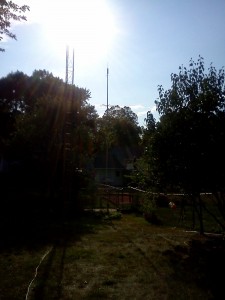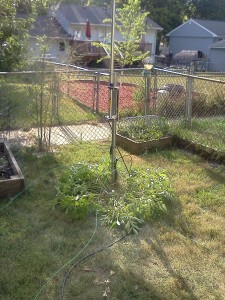Well the new 5BTV antenna arrived on Thursday, and after much work and fiddling I have it installed. The results are, mixed, at best.
First of all, my original idea to ground to the fence is out. There is too much noise carried on the fence, and it doesn’t seem to add any ground at all, just noise. So, if I’m going to be using this antenna long term I’m going to be installing ground radials.
Secondly, the noise floor isn’t that much lower than I expected. Here is a QSO I recorded of CJ6POP out of Canada. As you can see the background noise on 20M is about an S6:
Third, and perhaps most troubling, is during installation I had to do a significant amount of tuning of the built in traps to get low SWR readings on anywhere in the HAM bands. Pretty much everything I have read states that tuning the traps isn’t necessary unless you have an amazing ground system… which I don’t.
Building the 5BTV antenna was a simple process of simply unpacking the boxes, and reading the instructions. Lots of HAMs write about how complicated the antenna is to build, but frankly, I didn’t see it. I laid out the parts the night ahead of time (temperatures outside were in the mid 90s during the day) and then took the parts outside for construction early on the morning Friday. The construction itself took maybe 2 hours. However tuning took a lot longer. I logged over 19,000 steps on Friday walking between the antenna and the house, lowering it to make adjustments before measuring the SWR again.
Those things said the 5BTV is actually a decent antenna. It’s design is for places where the idea of a full dipole antenna is not practical. The first night after installing the antenna I made several DX (foreign station) contacts. I worked CK6S — a special event station for the 100th Anniversary of the Calgary Stampede. Moments later I worked YT9M from Serbia who reported I had a very strong signal (S9+10) and then about an hour later HC2AC from Equador. I worked several state side stations as well during the evening as well. Obviously, the antenna works.
So first tests reveal that more time is needed with the antenna to fully understand how it operates, to add some additional ground wires (and bury them) to completely tune the traps and antenna, and additionally to determine if I can figure out the source of the noise. We have had a lot of extra QRM (noise) due to the solar ejections, so perhaps this is not the best time to be testing the antenna. Only time will tell for sure.

